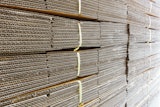 This article first appeared in IMPO's August 2013 issue.
This article first appeared in IMPO's August 2013 issue.
Plant explosions in recent months should serve as a reminder for industrial users to review their vacuums to ensure they are suitable in explosion-proof applications, such as those relating to combustible dust. In addition to satisfying OSHA requirements, manufacturers must also keep workers safe.
As Frank Intrieri Jr., vice president of sales with Goodway Technologies says, “explosion-proof vacuums are used in hazardous environments, so safety precautions are imperative.”
Tested And Certifiable
“A facility needs to use only certified explosion-proof vacuums,” Intrieri says, and these vacuums “must be certified for use in a hazardous environment by a nationally recognized test laboratory.” These labs “intensely” test the vacuum part by part to ensure that each and every part is grounded properly and is manufactured with non-sparking components. According to Intrieri, “the most commonly used test labs are UL, TUV, and CSA.”
Nationally recognized testing laboratories use specific marks to certify products for the purposes of OSHA product-approval requirements. OSHA accepts only products that contain a certified laboratory’s mark. UL (Underwriters Laboratories Inc.), TUV (TUV Rheinland of North America, Inc.), and CSA (Canadian Standards Association) are just three of these labs available for product testing. The NFPA, an international nonprofit, also provides (and advocates consensus) codes and standards, research, training, and education for industries dealing with issues such as explosion-proof vacuum safety.
Explosion-proof vacuums are certified by class and division, which dictates the areas the vacuum can be used in and the type of material that it can safely be used with. It is up to the facility to ensure that the vacuum certification matches the vacuum application at its location, says Intrieri. “In addition, the facility should be sure to use only approved anti-static vacuum hoses, accessories, and tools in conjunction with the vacuum.” With the right certified tools, explosion-proof vacuums can move one step closer to indeed being ‘explosion-proof.’
“The most basic requirement is to understand that the OSHA and NFPA standards are retroactive,” adds David Kennedy, sales manager with the vacuum cleaning division of VAC-U-MAX. “There is no such thing as a grandfathered industrial vacuum.”
Explosion-Proof
To have an explosion-hazard condition with an industrial vacuum, Kennedy says there are five necessary elements:
- Confinement (an enclosed vessel).
- A combustible fuel or powder.
- An oxygen-rich environment (inside the vessel).
- Dispersion (of the dust in the vessel).
- An ignition source.
“If you can remove one or more of those elements, you can prevent explosions from occurring inside the industrial vacuum,” Kennedy says. Oftentimes, industrial vacuum manufacturers will choose to remove the ignition element – sparks from an inappropriate shop-type vacuum motor, excessive heat from an electric motor, or friction, he explains. “The ignition source that is most feared is uncontrolled discharge of static electricity.” Anti-sparking contact parts are one way to remove the static electricity risk but, Kennedy says, “all vacuums should begin with a static-conductive (S/C) filter media and vacuum cleaning hoses and cleaning tools and methods to bond and ground the vacuum components.” If the vacuum operates on electric power, he explains, a starter or control panel and drive motor must be correctly rated for the environment: explosion-proof or TEFC motor and NEMA 7/9 or NEMA 4 enclosure for controls.
Other vacuums operate with a Venturi vacuum generator instead of a motor/vacuum pump combination, powered by a compressed gas. “Venturi-powered vacuums must be properly grounded and bonded as well and can be considered ‘intrinsically safe’ since they have no electrical components,” explains Kennedy. “There is no applicable North American standard for compressed-gas powered vacuums being utilized in an explosion-hazard environment because they are non-electrical products.”
While the first two elements, confinement and a combustible material, are impossible to remove from an industrial vacuum cleaner that is being used in a combustible dust environment, a specialized vacuum technique can be used to eliminate the oxygen-rich environment and dispersion, Kennedy says. “Submerged Recovery” (S/R) draws combustible dusts through an inerting “bath” of liquids in high-hazard applications, such as solid rocket propellant and NFPA 484 metal powders. “This technique can be utilized for water-reactive metal dusts through the careful selection of a non-water inerting liquid,” he explains. “Therefore, a submerged recovery industrial vacuum can eliminate [some of the] elements needed for an explosion.”
To be considered explosion-proof, portable vacuums “must have a ‘dirty-side’ volume less than eight cubic feet,” Kennedy says. “Otherwise the vacuum must be equipped with explosion venting or chemical suppression as per NFPA standards, effectively eliminating their ability to remain portable.”
Central or stationary vacuum systems, while they must also address the five elements of an explosion-proof system, can “easily meet NFPA standards and OSHA guidelines,” Kennedy says. While some central vacs are small enough to claim the eight feet, three inches exclusion for venting systems, larger systems can be “configured with explosion venting or chemical suppression, inlet isolation, and control panel pressurization/purging to address the specific plant conditions.” NFPA 654 (7.13.1.1) requires that air-material separators be located outdoors, unless it has explosion protection (venting, suppression, innerting, or containment) – or if the volume is less than eight cubic feet. Manufacturers looking to utilize this exception might do best to contact NFPA to be sure their system is following guidelines and is safe. Some industries can go with their preferences for their explosion protection equipment, while other will have fewer choices, “such as a central vacuum located in the middle of a manufacturing plant where chemical suppression and passive venting are the only practical choices,” Kennedy adds.
Safe Employees
While utilizing explosion-proof vacuums that are as ‘explosion-proof’ as possible, it is up to a facility manager to identify the risks. “The most important responsibility of a facility manager is to identify and/or admit that their dust or debris is combustible,” Kennedy explains. He continues to see many in the industry today who he says are simply unaware of the combustibility of the powders they are collecting because they have never had an incident. Others are dealing with “fugitive dust,” which doesn’t necessitate them looking up a Safety Data Sheet on the material. “Fugitive dust” remains suspended in the air, doesn’t come out of a vent or a stack, and generally isn’t a by-product of burning.
NFPA 654 directs employees to “manage change” in their workplace, which means they are also responsible for teaching employees and onsite contractors to use a vacuum cleaner instead of brooms and compressed air to blow off machinery, structures, and finished product. “Educating employees on standardized, accepted plant procedures is the most important thing that a plant manager can do to keep their employees safe,” agrees Intrieri.
“The second responsibility,” Kennedy continues, “is to inform the workers who are exposed to combustible dusts about the associated hazards and to establish an emergency response plan.” Clearly defining hazardous locations, identifying the proper certified maintenance equipment to be used in the hazardous locations, and giving the proper training on how to utilize that maintenance equipment is all part of a successful hazards plan, says Intrieri.
“When the facility manager has an understanding of their combustible dust, they can begin the process of identifying the best-available industrial vacuum to meet their needs,” adds Kennedy.
Investing In Safety
A key word when purchasing an industrial, explosion-proof vacuum is “investing” says Kennedy, “it is not ‘just’ a vacuum cleaner.” He adds that, in most cases, this investment will be a capital expenditure, “not a disposable shop-type vacuum.”
A responsible industrial vacuum supplier will take steps to ensure a manufacturer makes the appropriate, safe choice for their facility – asking about explosion hazards and the working environment. And the “responsible supplier will display intimate knowledge of the OSHA and NFPA standards and will be able to contribute to your overall hazard analysis, not just explain how to suck the powder into a vacuum hose,” Kennedy adds. “You also need the supplier to provide good documentation and design criteria to help the facility comply with NFPA recordkeeping standards.”
The detailed industrial, explosion-proof vacuum selection will start with the vacuum hose: diameter, air-powered or electric, single-phase electric or three-phase, dry or submerged recovery process, portable or central. Hose diameter and air versus electric powered are “judged based on convenience and available budget,” says Kennedy. And a central vac has “additional elements to consider,” such as inside or outside. If outside, these extra considerations can include air permits, climate conditions, and completion time for industrial users considering this type of vacuum.
“Purchase only a certified explosion-proof vacuum cleaner from a reputable company that will support the product with replacement parts in the future,” Intrieri says. “Make sure that the test lab used for certification is recognized by OSHA. Be certain that the vacuum cleaner certification class and division match the vacuum application that you have at your facility.”
As Kennedy says, “an explosion-proof vacuum is an investment in safety.”























